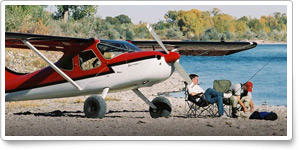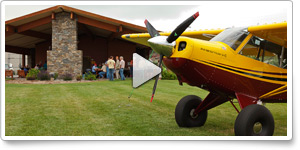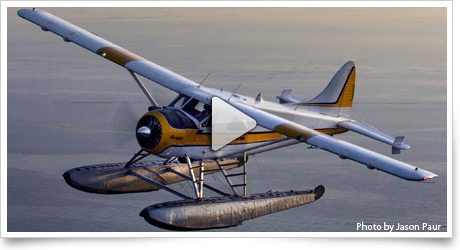| ||||||
| Where flying is ‘still fun’ |
| |||||
| Sponsored by: | ||||||
| Click here to see this week’s custom content. | ||
FeaturedWhere flying is ‘still fun’
| ||
GA NewsWhat goes around | ||||||||||||||||||||||||||||||||||||||||||||||||||||||||||||||
| | Your IFR rating in 10 days at your location … IFR finish-up in as little as 3 days! Professional teachers, specialized curriculum. IFR specialists for 30+ years. Whether flying G1000, Avidyne Entegra, Aspen, Cirrus Perspective or analog instruments, our instructors have the experience. Put “Instrument Rated” on your calendar NOW. 800-435-9437. Already Rated, but rusty? Our IFR Safety Course will get you current and make you a safer pilot. www.iflyifr.com |
Snow no match for Skype
Bad weather was no match for team spirit when AOPA President Craig Fuller reached out to South Carolina pilots recently. The South Carolina Aviation Association set up a Skype connection linking Fuller—grounded by an early snowstorm—to 973 attendees at the first-ever Southeast Aviation Show at Greenville, S.C., Downtown Airport. Read his blog about the Oct. 29 event.
Hawker’s financial figures improving
 Hawker Beechcraft lost money in the third quarter, but far less than in the comparable quarter for 2010. The company said that it “recorded an operating loss of $42.2 million, an improvement of $39.2 million as compared to an operating loss of $81.4 million during the same period of 2010.” It said the improvement was primarily because of one-time charges made during the third quarter of 2010. While the company saw improvements to gross margin, operating loss, and net loss, revenue was down. Read more >>
Hawker Beechcraft lost money in the third quarter, but far less than in the comparable quarter for 2010. The company said that it “recorded an operating loss of $42.2 million, an improvement of $39.2 million as compared to an operating loss of $81.4 million during the same period of 2010.” It said the improvement was primarily because of one-time charges made during the third quarter of 2010. While the company saw improvements to gross margin, operating loss, and net loss, revenue was down. Read more >>
| | Flying the same airplane without incident for 12+ months? You’re entitled to 10% claims free credits your first year with Avemco—15% your second! Also receive up to 10% off your annual premium with Avemco’s Safety Rewards. Learn more >> |
FAA proposes SR22T gasket AD
A proposed airworthiness directive affecting 67 Cirrus SR22Ts would require inspection and modification of the air box flange welds and slots, and installation of induction system air box seals as applicable. It was prompted by reports of partial loss of engine power when a dislodged rubber gasket was ingested into the turbocharger; the FAA estimates the cost to comply with the AD would be about $351.50 per aircraft. Comments on the proposal are due Dec. 19. Download the proposal >>

 Hover Power: Mast rocking
Hover Power: Mast rocking
On May 12, 2009, a Robinson R44 helicopter was damaged during a hard landing about 57 miles northwest of Iliamna, Alaska. The helicopter was flying about 300 feet above the ground when the pilot felt an unusual medium-frequency vibration in the controls. The pilot told the NTSB that the vibrations turned to oscillations in both yaw and pitch, to the point that he felt the helicopter was going to come apart. The NTSB discovered that operators of the Robinson R44 helicopter were aware of similar events and that the condition had been dubbed “chugging.” Read more >>
 Reporting Points: A legacy secured … it only took 30 years
Reporting Points: A legacy secured … it only took 30 years
The brand-new air traffic control tower at Memphis International Airport has a name: the Omlie Tower, for Phoebe Fairgrove Omlie. Omlie was the first woman to get an aviation mechanic license, as well as the first woman to earn a commercial pilot certificate, according to the University of Memphis Department of History. The department said the campaign to get some local recognition for Omlie began more than 30 years ago. Read more >>
| | Are you an iPad pilot? Sporty’s has you covered! Sporty’s is iPad headquarters, with the best selection of aviation apps, kneeboards, GPSs, mounts and accessories. And for exclusive tips and tricks, read our FAQ, watch our webinar and sign up for our email newsletter. It’s all at: Sportys.com/iPad |
![]()
Lake Buccaneer
For the perfect example of general aviation supporting the environment, The Aviators takes us to Canada’s boreal forest where one activist has learned to fly a Lake Buccaneer amphibian in support of preserving the area. Watch AOPA Live >>
For daily news updates, see AOPA Online.
Safety & Proficiency
Fly like a fighter: Look ma, one hand
On a 3,800-mile flight from Brisbane, Australia, to Okinawa, Japan, F-15C pilot Larry Brown worried that he'd have to make an embarrassing radio call to his flight lead. It was to be an eight-hour flight with six aerial refuelings, and for the moment he was doing some of the flying with his knees. He was trying to free his right hand, which had gotten stuck beside the seat trying to reach a gallon jug of water that had slid from its holding place. Brown applies lessons from his days in the F-15 to the world of general aviation. Read more >>
Too young to die
Every fatal accident is tragic, but the loss is particularly keen when an instant of bad luck or a moment of bad judgment ends a promising flying career before it’s fairly begun. On June 27, 2010, a 180-horsepower Piper Arrow took off from the Kalispell, Mont., City Airport. The 25-year-old, 100-hour private pilot had rented the airplane to take three friends on a sightseeing flight over Flathead Lake and Glacier National Park. Two of the passengers were expected at a barbecue later that afternoon, and the airplane was reported missing after they failed to arrive. Read more in this special report from the Air Safety Institute.
Learn how to make the tough calls easier
 Spend some time looking through the NTSB accident database and you’ll notice that the root cause of most accidents is not mechanical failure, or a freak weather event, or anything else that just “happened,” but poor decision making on the part of the pilot. The good news is that it doesn’t take exceptional judgment or tons of experience to make consistently good choices in the air. Learn more in the Air Safety Institute’s Do The Right Thing: Decision Making for Pilots Safety Advisor.
Spend some time looking through the NTSB accident database and you’ll notice that the root cause of most accidents is not mechanical failure, or a freak weather event, or anything else that just “happened,” but poor decision making on the part of the pilot. The good news is that it doesn’t take exceptional judgment or tons of experience to make consistently good choices in the air. Learn more in the Air Safety Institute’s Do The Right Thing: Decision Making for Pilots Safety Advisor.
 IFR Fix: A bad vector
IFR Fix: A bad vector
“This isn’t going to work,” you say aloud as you roll out on the assigned vector and prepare to shoot the approach. Good thing this is just practice. Under instrument meteorological conditions this scenario could be nerve wracking. Maybe your workload would have prevented you from even seeing the problem developing. Have you ever had to miss an approach in IMC? Read more and take the poll >>
| | Aspen Glass 2K Savings. Instantly save more than $2000 on Evolution 1500 or 2000 system purchases made before Dec 31. Aspen glass increases situational awareness and reduces pilot workload. Features include: built-in system redundancy, SV, traffic/weather, and seamless integration with your existing radio, nav, and autopilot. Click for details >> |
Don’t let ice drag you down
 With the cold air of winter comes the likelihood of an icing encounter. What should you do if ice starts accumulating on the airframe around you? If your airplane isn't equipped to handle it, you'll need to make quick decisions. Take the WeatherWise: Precipitation & Icing online course from the Air Safety Institute and learn about potential ice-inducing weather conditions to steer clear of, as well as what to do when the ice starts building.
With the cold air of winter comes the likelihood of an icing encounter. What should you do if ice starts accumulating on the airframe around you? If your airplane isn't equipped to handle it, you'll need to make quick decisions. Take the WeatherWise: Precipitation & Icing online course from the Air Safety Institute and learn about potential ice-inducing weather conditions to steer clear of, as well as what to do when the ice starts building.
‘Fall back’ Nov. 6
Daylight saving time ends Nov. 6, so be sure to set your clocks back—and don’t let nighttime’s early arrival catch you aloft with passengers if you’re not night current. If you’re filing a flight plan or checking weather forecasts, remember that the conversion between Zulu and local time will change for most pilots in the United States. Here’s a chart to help you make the adjustments.
 Leading Edge: When it snows…
Leading Edge: When it snows…
It is awe-inspiring the things we can do with aircraft. Thousands of times a day, the airlines fly people to their destinations more or less on time with luggage usually not far behind. However, when a snow storm fouls the Northeast, it all falls apart. The news of a Jet Blue flight stranded on the ramp at Bradley International Airport is something from another world. It’s similar to being trapped on an escalator! Read more >>
| | PLUG & PLAY - NO PAY For a limited time only, PS Engineering will pay for the installation cost to upgrade your existing GARMIN GMA340 with a PMA8000 audio panel. Click Here to Learn More! |
Flight Instructor Refresher Clinics | Air Safety Institute Safety Seminars | |||||||||
For a complete schedule, see AOPA Online. Can’t make it in person? Sign up for the CFI Refresher Online. |
Topics vary—for details and a complete schedule, see AOPA Online. | |||||||||
ADVOCACY
Aviation groups: Costly proposals won’t work
Debt-reduction proposals that would hike fees on all aviation “would lead to significant job loss across all sectors of the industry and the nation,” a broad coalition of nearly 30 aviation organizations told Congress Oct. 27. In a joint statement, AOPA and organizations from all aspects of aviation urged Congress to reject two proposals that would add significant cost to users of the National Airspace System: a $100-per-flight departure fee, and an increase to the passenger security fee. Read more >>
Senators take GA’s case to White House
U.S. Senate GA Caucus member Jerry Moran (R-Kan.) and 22 co-signers took the case against general aviation user-fees to the White House this week, as a congressional deficit-cutting “super committee,” facing two key deadlines, pursued its $1.5 trillion task. With 14 million Americans looking for work and GA efficiently providing communities with critical services, increasing taxes on GA will only further stifle economic recovery, the senators said. Read more >>
| | Experience the Garmin 3-D Audio Difference Advanced audio processing in Garmin’s GMA 350/350H audio panel helps you differentiate between the audio inputs coming into your headset. When multiple COM radio sources are monitored, they seem to come from different locations around you. Try the demo today. |
 Medical Sense: Self-certification 2.0
Medical Sense: Self-certification 2.0
 With the FAA, a request for a change has to demonstrate an equivalent or greater level of safety than what is currently in place. The argument against doing something different often is, “There is no data to support it.” But there is rarely, if ever, any data to support something that’s never been done before. AOPA and the Experimental Aircraft Association will soon request an exemption—the latest in a series of similar requests—that would allow pilots to fly recreationally with a driver’s license/self-certification medical standard. This time, the associations come armed with data from the sport pilot rule. Read more >>
With the FAA, a request for a change has to demonstrate an equivalent or greater level of safety than what is currently in place. The argument against doing something different often is, “There is no data to support it.” But there is rarely, if ever, any data to support something that’s never been done before. AOPA and the Experimental Aircraft Association will soon request an exemption—the latest in a series of similar requests—that would allow pilots to fly recreationally with a driver’s license/self-certification medical standard. This time, the associations come armed with data from the sport pilot rule. Read more >>
Keep flying: Beyond medical certificates
If a third-class medical certificate, with its costs and burdens, isn’t necessary for pilots who fly small, single-engine aircraft for recreational purposes, why not request that it be eliminated? The FAA's negative responses to past requests demonstrate that the agency is not ready to take the leap of removing the requirement for a third-class medical. But the industry has had more success seeking incremental changes. Read more >>
| | AOPA Aircraft Financing Program offers NEW lower rates Our goal is to get pilots into the aircraft of their dreams. To help make aircraft ownership more attainable we just lowered our rates to make monthly payments more affordable. For more information, or to have a representative call you to discuss financing, go to www.aopa.org/loans. |
LightSquared plan ‘not acceptable’ to GA
Companies from agriculture to aviation rely on GPS, making signal interference problematic for business, said House Committee on Small Business Chairman Rep. Sam Graves (R-Mo.). In a letter to the Federal Communications Commission, Graves requested that the agency “outline” its review of LightSquared’s proposed wireless network, shown by tests to disable GPS. Read the letter >>
King Air pilots needed for LPV study
 The FAA is seeking King Air pilots to participate in a simulation study assessing airport infrastructure requirements for supporting localizer performance with vertical guidance to a decision altitude of 200 feet (LPV 200) approach operations by Approach Category A and B airplanes. The study’s goal is to make precision approaches available to more runways, improving safety of operations. Pilots must be current in any model of King Air, and be instrument-rated with a current medical certificate, without a night flight or color signal control restriction. Read more >>
The FAA is seeking King Air pilots to participate in a simulation study assessing airport infrastructure requirements for supporting localizer performance with vertical guidance to a decision altitude of 200 feet (LPV 200) approach operations by Approach Category A and B airplanes. The study’s goal is to make precision approaches available to more runways, improving safety of operations. Pilots must be current in any model of King Air, and be instrument-rated with a current medical certificate, without a night flight or color signal control restriction. Read more >>
| | AOPA Insurance Agency offers the right coverage at the right price We work with A-rated underwriters and offer the most coverage options to fit your needs for the aircraft you own or rent. Call 800-622-AOPA or go online for a free quote. |
Member Benefits
New, free program offers members discounts
 A new, free membership benefit offers AOPA members discounts on anything from headsets to car rentals. Aviation and nonaviation companies offering discounts on products and services will be featured in the AOPA Lifestyles Member Discounts program. Discounts from companies such as Aircraft Spruce, PilotEdge, PilotMall, and Sporty’s Pilot Shop can save you enough money to pay for your membership—and get back in the air more often. Read more >>
A new, free membership benefit offers AOPA members discounts on anything from headsets to car rentals. Aviation and nonaviation companies offering discounts on products and services will be featured in the AOPA Lifestyles Member Discounts program. Discounts from companies such as Aircraft Spruce, PilotEdge, PilotMall, and Sporty’s Pilot Shop can save you enough money to pay for your membership—and get back in the air more often. Read more >>
AOPA Rescue Knife: A survival gear necessity
AOPA’s Rescue Knife packs a lot of features into a small space, making it ideal to carry in a flight bag or in a pocket. Although the blade is just three inches long, it is strong enough and sharp enough to cut rope, rubber hose, and more. The knife also features a protected blade for safe seat-belt cutting. When not on a flight, the knife is a handy tool to keep in your hangar for any number of tasks. The handle is actually a sharpened window punch for fast emergency use. Read more >>
Charitable flying: Win-win
Members often contact AOPA about how they can sponsor a community flying event to raise funds for civic groups, churches, or youth groups. In addition to raising financial support, these events introduce participants to flying and build camaraderie between the community and the airport. Learn how you can get involved in charitable flying in the AOPA Pilot Information Center’s recorded Webinar. Watch AOPA Live >>
| | FREE Video Tip! — Courses for Beginner to Pro! Click for a Free Video Training Tip and find a course to achieve your next goal, or to make your flying safer and more rewarding. Not sure? Call us at 800-854-1001 and talk to one of our pilot training advisors. |
AOPA 2012 Tougher than a Tornado Sweepstakes
Hard work in wild places
 The story of AOPA’s 2012 sweepstakes Husky begins with the Recreational Aviation Foundation. The Husky was the anchor of the RAF display at Sun ’n Fun on March 31, when winds that exceeded 90 miles an hour pulled the airplane from its tie-downs and damaged its fabric and control surfaces. RAF President John McKenna nicknamed N40WY “tougher than a tornado” and suggested it would be perfect for the sweepstakes. In the RAF’s characteristically blunt, plain-spoken fashion, he got busy making things happen. “We in the RAF tend to say what’s on our minds,” said McKenna, a Cessna 185 pilot and longtime resident of Bozeman, Mont. Read more and watch AOPA Live >>
The story of AOPA’s 2012 sweepstakes Husky begins with the Recreational Aviation Foundation. The Husky was the anchor of the RAF display at Sun ’n Fun on March 31, when winds that exceeded 90 miles an hour pulled the airplane from its tie-downs and damaged its fabric and control surfaces. RAF President John McKenna nicknamed N40WY “tougher than a tornado” and suggested it would be perfect for the sweepstakes. In the RAF’s characteristically blunt, plain-spoken fashion, he got busy making things happen. “We in the RAF tend to say what’s on our minds,” said McKenna, a Cessna 185 pilot and longtime resident of Bozeman, Mont. Read more and watch AOPA Live >>
AOPA Career Opportunities
Ever dream of turning your passion for aviation into a career? We’re looking for a director of media relations, AOPA Live producer/videojournalist, Web business analyst, medical certification assistant, associate editor–Web, associate editor–Web/ ePilot, .Net developer, aviation technical specialist, and manager of airspace and modernization. To learn more about other AOPA career opportunities, visit AOPA Online.
Community
Picture PerfectAOPA’s online photo gallery allows you to upload your own aviation photography as well as view, rate, and comment on others’ photos. Your favorite aviation images from AOPA Pilot are still available online through this new gallery. Take a look, and submit your own photos! | | |
Rally GACheck out user-submitted events from your region. To include an event or to search all events in the calendar, visit AOPA Online. AOPA does not endorse the events listed below, nor have ePilot editors edited the submissions. AOPA assumes no responsibility for events listed.
| |
| |
QUIZ ME!Here’s a question asked by an AOPA member who contacted our aviation services staff through the AOPA Pilot Information Center. Test your knowledge.
Question: I’m currently training for my sport pilot certificate (airplane single-engine land) with a certificated flight instructor (CFI). I’ve heard that there are training implications depending on whether I train with a CFI versus a light sport instructor, if I want to go for my private pilot certificate in the future. Could you explain?
Answer: The current regulations stipulate that any flight training time (also known as “dual instruction received” or “dual received” in your logbook) applied toward a recreational or private pilot certificate must be provided by an “authorized instructor.” This language can be found in FAR 61.99 and 61.109 for recreational and private pilot training. Unfortunately, the FAA has provided a letter of interpretation that currently disallows training time given by a sport pilot instructor from applying toward higher ratings, stating that “such action is clearly neither permitted by the regulations nor the intent of the 2004 final rule.” As a result, it is worth discussing your training intentions with your instructor so that you can maximize your training time and dollars if you decide to train for a higher rating once your sport pilot training is complete. Looking forward, AOPA has submitted a petition to allow sport pilot training time to count for higher ratings, regardless of whether the instructor holds a CFI or a light sport instructor certificate. Learn more and find out how to submit your comments on the subject in AOPA’s article, “Tell FAA to count sport pilot time toward higher certificates.”
Got a question for our aviation services staff? The AOPA Pilot Information Center is a service available to all members as part of the annual dues. Call 800/USA-AOPA (800/872-2672), or email to [email protected]. |
| |
|
|
| |
| | ||||
| ePilot Editor: Sarah Brown | Contributors: Alyssa Miller Jill W. Tallman Warren Morningstar Alton K. Marsh | | Production Team: Melissa Whitehouse Lezlie Ramsey Mitch Mitchell William Rockenbaugh | Advertise in ePilot: |
| Member Tools: Send feedback | Update member profile/email | Unsubscribe | ePilot Archive © 2011 Aircraft Owners and Pilots Association | 421 Aviation Way Frederick, MD 21701 | Phone 800/USA-AOPA | Fax 301/695-2375 | ||||










